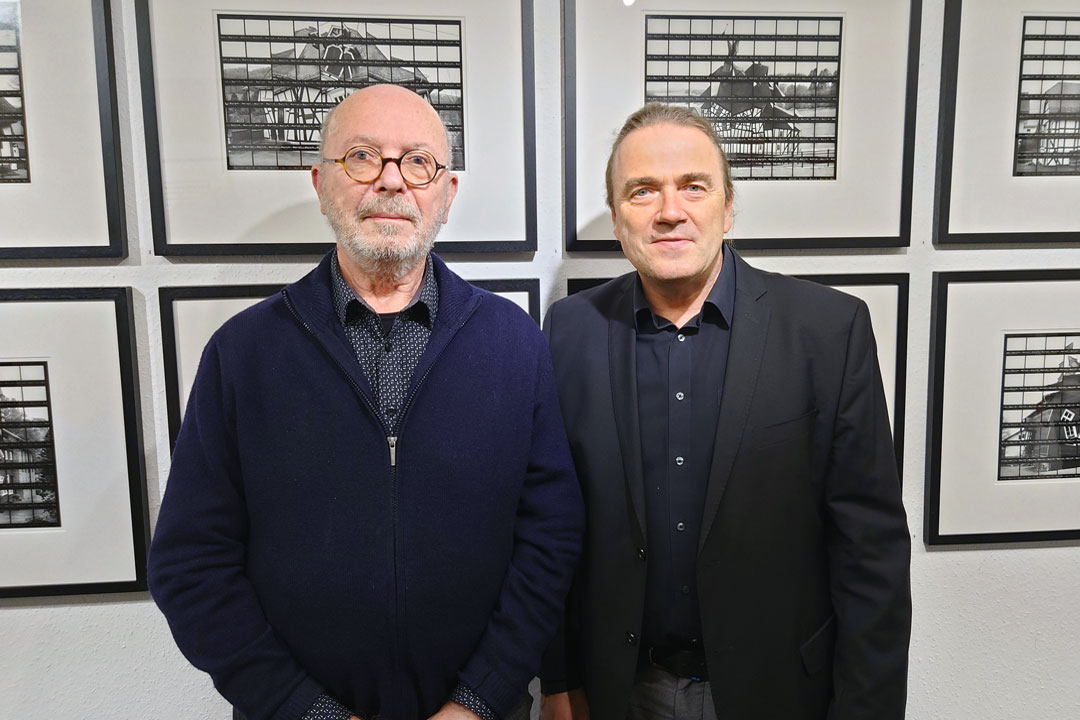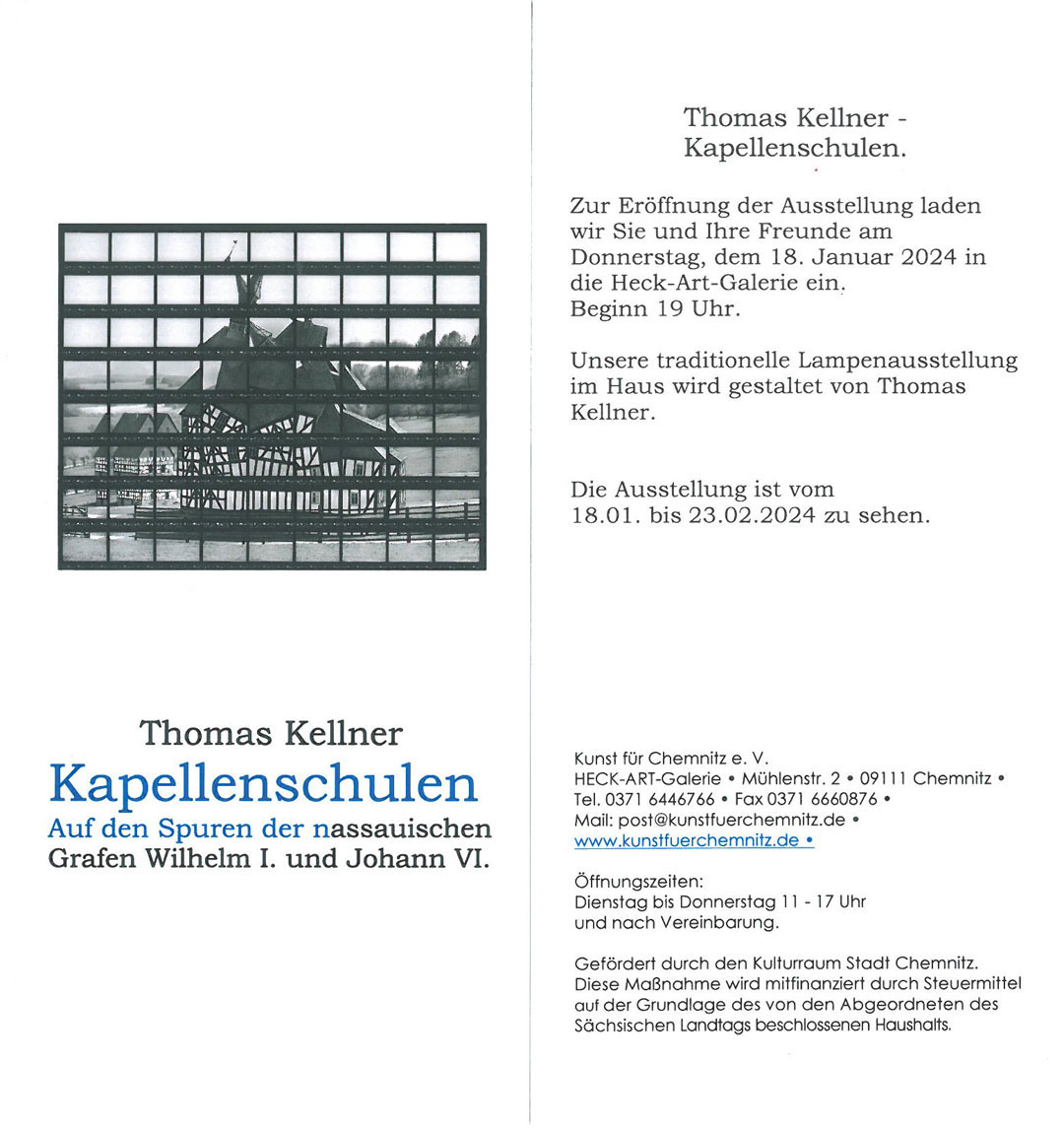Art Chemnitz: Chapel Schools

Art Chemnitz presents Chapel Schools at Heck-Art-Galerie
Chemnitz. On January 18, Kunst für Chemnitz opened the exhibition Thomas Kellner Kapellenschulen at the Heck-Art-Galerie. Thomas Ranft, the second chairman, spoke with Thomas Kellner about the Nassau chapel schools, the analog photography of the contact sheet and Kellner's technique of deconstruction in an artist talk in front of a large audience.
Art Chemnitz and the Chapel Schools

In 49 pictures, the artist Thomas Kellner explores a part of our regional history, oscillating between art and documentation. The chapel schools form a solitary architectural type for the Siegerland and neighboring regions. As individual buildings that stand out in their surroundings, they reveal the connection between church and state, starting from the territory of Count Wilhelm von Nassau-Dillenburg (* April 10, 1487 in Dillenburg; † October 6, 1559 ibid.).
Having already explored Siegen's industrial culture in the form of industrial architecture in his Genius Loci series and followed in the footsteps of Bernd and Hilla Becher with the half-timbered houses in the Siegen industrial area, Kellner's chapel schools complement his artistic treatment of the regional architectural landscape. The chapel schools were realized in Kellner's typical cubist-deconstructed style, which was described by Prof. Dr. Irina Chmyreva as 'Visual Analytical Synthesis' or by Prof. Dr. Rolf Sachsse as 'Modern Mannerism' and sets the motif visually in motion.
Chapel schools are buildings in which both church services and school lessons were held and therefore reflect the close connection between church and state. The initiator was Count Wilhelm von Nassau-Dillenburg, who in 1532 instructed the priests to teach seven to fourteen-year-old children in a central location on public holiday afternoons. This concept was expanded so that eventually a chapel school was established in almost every village. School and place of worship were thus combined in one building, but the rooms could also be used for other purposes. This made the chapel school a multifunctional building that was used until the end of the 19th century and in parts even into the 20th century. Its typical appearance is that of a half-timbered building, often slated and often with a small tower for the bell.
The project was supported during research and implementation by grants from the Ministry of Culture and Science of the State of North Rhine-Westphalia and Neustart Kultur from the Federal Government Commissioner for Culture and the Media through the Stiftung Kulturwerk of VG Bild-Kunst. Now on view at Heck-Art-Galerie. Art Chemnitz
The Nassau Chapel Schools in Chemnitz
The chapel schools form a solitary type of architecture that reveals the connection between religion and school education. As a result, religious services and school lessons are combined in one building, which classifies the chapel schools as hybrid buildings. The term chapel school resulted from the partial integration of the schools into existing chapels and has become established, particularly in the Siegerland and neighboring areas, as a result of geographical and political connections. The artistic examination of the chapel schools aims to preserve and recall this cultural asset typical of the region through a new medium. Last but not least, historical ignorance and a lack of interest led to the sale, demolition or conversion of a large number of dilapidated chapel schools in the post-war period. In 49 motifs, Thoms Kellner therefore devotes himself to a regional and cultural-historical theme: the chapel schools.
The architectural appearance
The hybrid use of the chapel schools is architecturally anchored and is reflected in a building type that oscillates between profane and sacred. The external appearance of the Kappelen schools is not linked to religion and does not reveal the denominational affiliation either through the façade design or building construction or through the room layout. The buildings are primarily characterized by their functional design. The only indications of religious use are a ridge turret with a bell and, in places, a five-fifths closure of the choir, as well as the interior design, which allows conclusions to be drawn about the denomination, at least in the interior. In addition to its educational and religious use, the chapel school was a multifunctional place for the community, which continues to this day. It was precisely the proximity of the chapel schools to bourgeois residential buildings that facilitated a detachment from the religious context and enabled a change of use after the buildings had become too small for school lessons.
William I and John VI
Count William I, known as the Rich, and his son John VI, known as the Elder, are regarded as the initiators of the chapel schools. William, who had witnessed Luther's failure to recant his theses and writings at the Diet of Worms in 1521, paved the way for the Reformed faith in his dominion. While he introduced measures against the sale of indulgences as early as 1518, it was not until the introduction of the Brandenburg-Nuremberg Church Order in 1534 that the Lutheran Reformation was brought about in the county. In 1578, his son John VI introduced the Reformed confession in Nassau-Dillenburg and Nassau-Siegen. During his reign, faith and education became particularly important, so that he is regarded as a patron of schools and, from 1567, of chapel schools. The resulting nationwide establishment of schools with lessons for boys and girls as well as the increasing standardization of teaching was part and parcel of literacy.
The role of faith
When the Reformed confession was introduced in Nassau-Dillenburg and Nassau-Siegen under John VI in 1578, the population was faced with a second change of confession within 44 years. Parts of the population were critical of the new rite associated with it, but the change was basically in agreement with the Siegen town council. This was not only a supporter, but also the initiator of the conversion to the Reformed faith. The change of confession was the trigger for an educational offensive on the part of John VI, the aim of which was to bring the theology of the catechism and the Reformed faith to the population through education. Boys and girls were taught to read and write in chapel schools, undoubtedly on the basis of the catechism. From 1624, John VIII attempted to re-Catholicize the hereditary lands. He was only successful in Netphen and parts of the town of Siegen.
Kellner's chapel schools
By transferring the cultural heritage of the chapel school into an artistic framework through the medium of photography, Thomas Kellner gives this in many respects historical subject a new dimension in contemporary art. Technically, he draws on the elementary structures of the architecture of the chapel schools and their hybrid use, embodied by religion and school education. The grid of contact arches used by Kellner can be found in the open framework or the slate cladding of the façades, the various tilting moments in the picture are in line with the multifunctional use of the spaces, and the multi-perspective realization reflects above all the interrelationship between religious and scholastic use. The view of the past only ever works from a present perspective. Kellner uses his photographic-artistic position for this and knows how to rethink the view of the chapel schools while remaining true to his own artistic past.
Thomas Kellner - Chapel schools. In the footsteps of the Nassau Counts Wilhelm I and Johann VI.
13.11.2022 – 11.2.2023 Artgalerie, Siegen
10.11. –01.12.2023 Galerie Grevy, Cologne
18.01.–23.02.2024 Kunst für Chemnitz e. V.
Information for Chapel Schools Art Chemnitz
Chapel Schools
January 18 – February 24
Kunst fuer Chemnitz in der Heck-Art-Galerie, Chemnitz, Germany
Heck-Art-Galerie
Muehlenstraße 2
DE 09111 Chemnitz
Germany
Opening hours
Tuesday - Thursday 11 a.m. to 5 p.m.
and by appointment
Tel.: +49 371 6446766
Mail: post@kunstfuerchemnitz.de
Web: www.kunstfuerchemnitz.de








